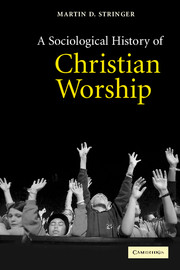Book contents
- Frontmatter
- Contents
- Preface and acknowledgements
- Introduction: Discourse, devotion and embodiment
- 1 Early Christian worship, texts and contexts to ad 300
- 2 Worship and the Christianisation of public space, 300–600
- 3 Hegemonic discourses in the worship of empires, 600–900
- 4 The dominant discourse of cosmological Christianity, 900–1200
- 5 Accessing the demotic discourses of devotion, 1200–1500
- 6 Worship and the rise of humanistic discourses, 1500–1800
- 7 The globalisation of Christian worship, 1800–2000
- Bibliography
- Index
Preface and acknowledgements
Published online by Cambridge University Press: 03 December 2009
- Frontmatter
- Contents
- Preface and acknowledgements
- Introduction: Discourse, devotion and embodiment
- 1 Early Christian worship, texts and contexts to ad 300
- 2 Worship and the Christianisation of public space, 300–600
- 3 Hegemonic discourses in the worship of empires, 600–900
- 4 The dominant discourse of cosmological Christianity, 900–1200
- 5 Accessing the demotic discourses of devotion, 1200–1500
- 6 Worship and the rise of humanistic discourses, 1500–1800
- 7 The globalisation of Christian worship, 1800–2000
- Bibliography
- Index
Summary
The origins of this book go back to my final year at University in Manchester when I sat through a course on the History of Liturgy delivered by Richard Buxton and Kenneth Stevenson. I remember sitting, even then, thinking that one day I would really love to deliver a course of this kind. My own course, however, would look nothing like that offered by Richard and Kenneth. This is not to say anything against the course itself; I learnt a great deal from it, and it inspired many different thoughts that have ultimately led to this book. I am very grateful for all that they taught me. It was simply that at the time I was taking a degree in Social Anthropology and the approach to liturgy taken by Richard and Kenneth was basically textual. I could see so many possible connections between the work that I was doing in anthropology and the material I was being presented with in the course on liturgy. I was just dying to bring the two together.
Twelve years later, having been appointed as a Lecturer in the Sociology and Anthropology of Religion at Birmingham University, I was invited by the then Head of Department, Frances Young, to offer a course on the History of Liturgy for the B.A. in Theology. This was my chance to bring together all the reading and reflection that I had done in the previous twelve years and to create the kind of course that I wanted to teach.
- Type
- Chapter
- Information
- A Sociological History of Christian Worship , pp. vii - viiiPublisher: Cambridge University PressPrint publication year: 2005



